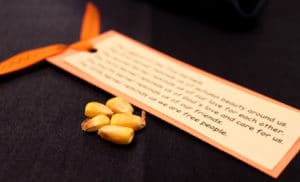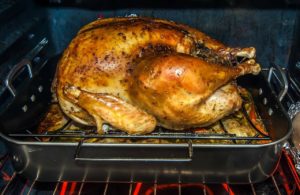
Since March, we all have experienced change in our lives regardless of age, gender, place of employment, socio-economic level or geographic location. We’ve seen disruptions in our food distribution systems, a rise in food costs and food insecurity, and the personal sacrifice of essential food and health care workers. We are tired and frustrated and questioning how something so minute can cause a global pandemic.
Yet, along the way we have seen resiliency in action when individuals, communities, organizations and industries have come together to address hardships caused by the pandemic. There are “silver linings” if we look for them. This year, perhaps the best tradition we can start is being grateful for one of the basics of life — our food — which we’ve often taken for granted.

Our Food Manufacturers and Retailers
Food is at the core of our existence and celebrations. When food started disappearing off grocery shelves earlier this year without immediate replacement, panic set in. Our expectations of bountiful choices of any type of food — fresh, frozen or canned — (along with the essential toilet paper) was put to the test. Quickly, we filled our carts to the brim as the home kitchen became the center of our universe. Today, with a new surge of COVID cases, most of us realize we don’t have to stockpile.
A recent Consumer Brands survey found that only about a third of shoppers were buying more toilet paper and cleaning supplies with a slight increase in shelf stable foods.2 The good news: both the seller and buyer are prepared. Manufacturers anticipated increased demand and are doing everything they can to keep products on the shelves, including instituting 24-hour shifts, narrowing product offerings, ensuring maximum production, and implementing direct shipments to cut down on the time it takes to get product to stores. As consumers, we have learned that food and supplies will not disappear … at least not permanently. Like manufacturers, retail stores have pivoted over the past months to respond to the rapid rise of online shopping while also increasing safety protocols to maintain a safe environment for workers and shoppers.
Our thanks to the essential frontline workers who put in the long hours to process our food, fill online carts and stock the shelves!
Our Farmers and Ranchers
Resiliency is the core existence of any farmer or farming operation, but this year has been a challenge. With the rapid disruption of the food supply chain in early spring, produce and dairy farmers initially faced the stark reality of “no place to go” with their products but quickly rebounded to redistribute to food banks and fill grocery shelves as systems changed to accommodate the situation. Despite the economic loss and mental strain, our farmers and ranchers didn’t give in. We saw the growth of local and regional agriculture as more farms turned to direct consumer sales, reassuring consumers that food was available.

As we move forward in 2021, it will be important for us, as consumers, to support a variety of food systems if we wish to see a more diverse food supply. Farming has always been a risky business. This year’s COVID setbacks coupled with drastic weather conditions in some regions and a challenging trade environment only added to that risk.
Our thanks to our farmers — small and large, local and global. And our most grateful appreciation to all the farm workers who risk their health harvesting the produce, processing the meat and milking the cows. The fruit of their labor ensures food on our table.
Our Community Food Banks and Volunteers
Hunger has always been a reality locally and globally but is often swept aside unless we are directly impacted as a provider or recipient. Suddenly, this spring, the reality of the situation became more real for all of us as we watched cars line up in parking lots across the country for food assistance. As I’ve mentioned in earlier blogs, food banks and shelters, along with USDA School Nutrition Programs and new initiatives such as the Farm to Food Box Program,4 have been the shining lights of this pandemic.5 This need is not going away. One of the best ways all of us can thank our community organizations is to make a monetary donation to food banks or food pantries. Money is better than donated food during this time due to the lack of volunteers to repack donated foods. Donations to your state or the national Feeding America program,6 area emergency shelters and nonprofits will make a difference. Also consider volunteering if the situation presents itself. One of my friends states she volunteers because “It’s the least I can do as I don’t have to worry where my next meal is coming from like so many families in this country.”
Our thanks to food bank employees, school nutrition professionals and the many volunteers who have worked so hard this year to connect food to families in need.
Our Food Service Community from Schools to Restaurants
During this pandemic, the shutdown of schools and foodservice establishments has created unparalleled challenges. Resourceful, resilient, flexible and committed are all characteristics shared by those who work tirelessly in the School Nutrition Program and foodservice establishments to keep food on the table for those in need. And even though our kitchens are still the center of our existence, we are experiencing “cooking fatigue.” Here’s a win-win. Support your area restaurants not only as a way to “give yourself a break” but more importantly, to help local business owners and the economy. We are all in this together.
Our thanks to those in the foodservice community who faced unprecedented challenges this year.
Our Gratitude = Better Attitude

As we prepare to celebrate in our own way, let’s pause and think about the countless hands from the farm worker to the grocery store clerk or the local farmer and restaurant worker who have worked (and continue to work) through significant challenges to make sure we have food on the table. They are truly a lesson in resiliency.
It is our turn to be grateful. Don’t miss the opportunity. My thanks to each of you!
References
1. “400 years on, the Pilgrims get a reality check,” by Bill Newcott, National Geographic, November 11, 2020.
2. “How Consumers Are Handling the Pandemic Surge” by Thad Rueter, Progressive Grocer, November 17, 2020.
3. Jayson Lusk, Food and Agricultural Economist
4. Farmers to Families Food Box Program, U.S. Department of Agriculture
5. “Shining Stars Among Grim Realities,” by Marianne Smith Edge, May 31, 2020.
6. Feeding America
7. “In Praise of Gratitude,” Harvard Mental Health Letter, June 5, 2019.
